Tested: 2005 Off-Road SUV Comparo
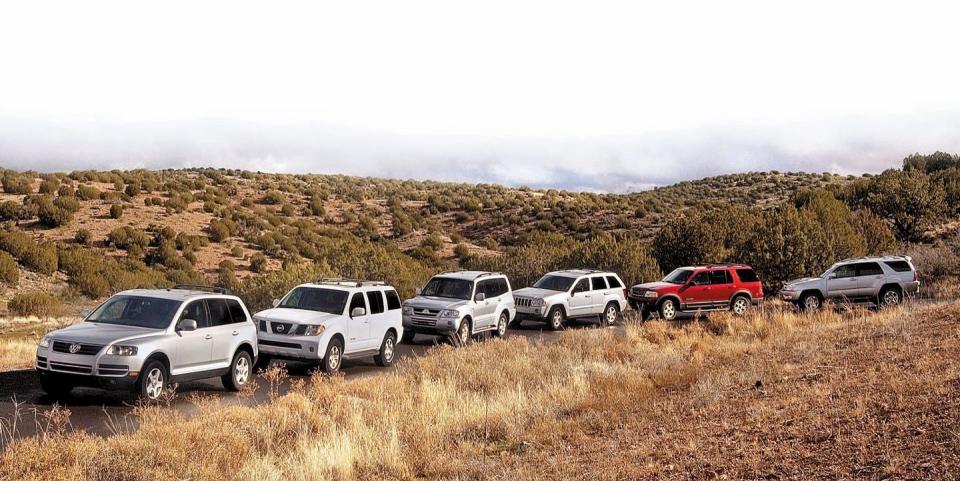
From the April 2005 issue of Car and Driver.
Mother Nature started her landscaping for this comparison test 275 million years ago, when she washed a bunch of quartz sand with rusty water until the grains took on a pretty red hue and then cemented them together to form sandstone bedrock. Over the ages since, she hoisted this one-time sand pile upward by 4600 feet and set about sculpting it into a lofty lump that today's residents of Sedona, Arizona, call Chicken Point.
Not that most of them get to see this particular sample of her handiwork. Mother hid it well behind a spellbinding array of other rocks, all of which seem to have more appealing names.
Chicken Point is hidden but not forbidden. There's a trail—Broken Arrow—barely wide enough for one vehicle over most of its 2.1-mile length. Thrill-seeking visitors buy a ride in the Jeeps of a local tour company. But if you have a 4x4 and are willing to risk ripping the bottom out of it, you can attempt the journey yourself.
Hmm. Could we urge a six-pack of grocery getters up to Chicken Point without leaving 5W-20 slicks from savaged oil pans or embarrassing ourselves with a call for helicopter evacuation? Only one way to find out.
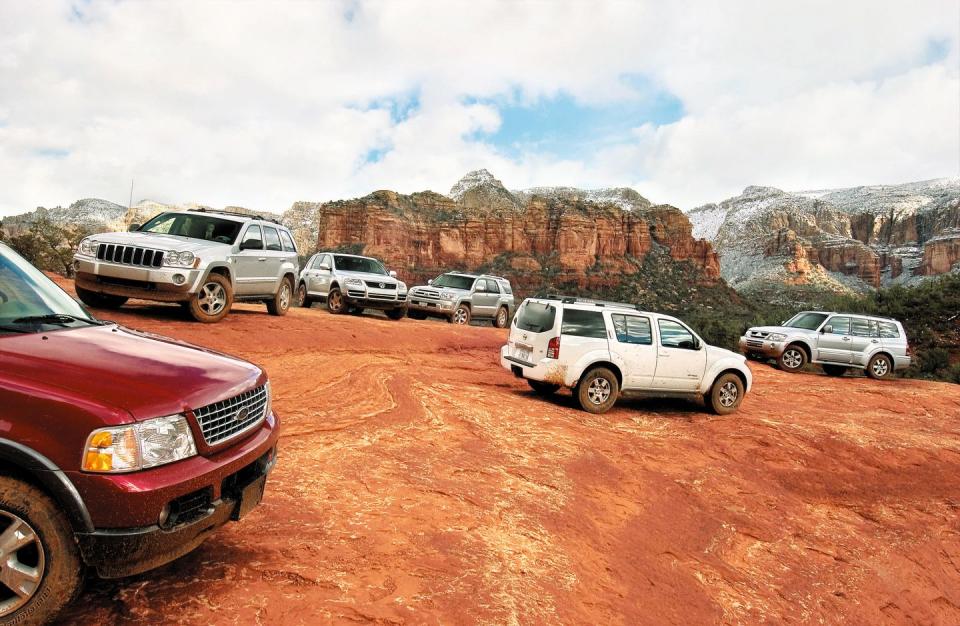
Exactly which SUVs? First, the all-important qualifier: The vehicles must have low and high ranges. Broken Arrow is a slow-speed trek demanding plenty of ground clearance and driver expertise.
The spring season has two all-new mainstreamer SUVs: the Jeep Grand Cherokee, now with Hemi power, and a Nissan Pathfinder built on Titan bones. Both have the climber's swagger. Toyota's athletic 4Runner is certainly right for the mission. The optional V-8 won't go breathless on us at altitude. The Mitsubishi Montero has intriguing off-road capability, too, including the ability to be shifted from rear drive to all-wheel drive on the fly at speeds up to 62 mph.
From VW, the agile Touareg might be pulled down to popular prices if we stay with the standard 237-hp, 3.2-liter V-6. We're aiming for a base sticker in the $35,000-to-$40,000 range.
What about the most ubiquitous SUV ever, 14 years as an American bestseller: the Ford Explorer? With two-wheel drive, it's as common as dandelions. Instead, we'll opt for AdvanceTrac full-time all-wheel drive and Roll Stability Control. The price? Uh, a blur of incentives lets you buy an Explorer right. And if these rebates were as predictable as, say, lunar cycles, we could pull them into our as-tested calculation. They aren't. We can't. Let's just say we welcome Mommy's favorite ballet bus to the climb, and if it can do a demi-plié on Chicken Point, there'll be high-fives in PTA meetings across the land.
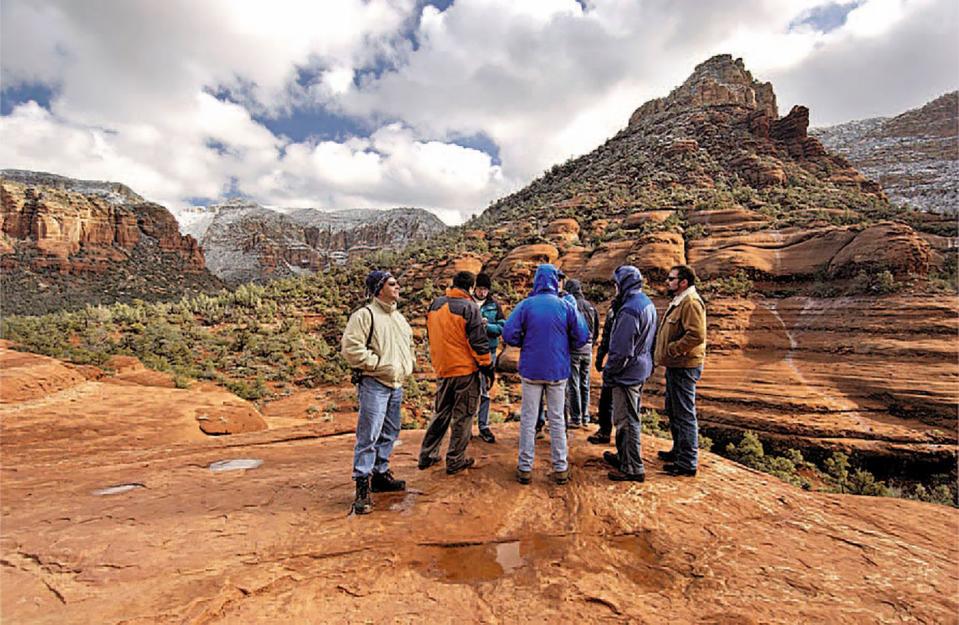
At the risk of getting all Lewis-and-Clark on you, we hired a geologist to accompany us. Inquiring minds want to know why the rocks of Sedona are red, and why does that redness stop just beyond the edge of town?
Geologist Wayne Ranney explains rocks as if he had baked them himself. He helped us see that the red is really just a stack of layers about 1400 feet thick, situated partway up a much taller cliff. Look northeast of Sedona: The high ground is tan. Those lighter-colored layers above the red start about a mile above sea level; they covered Sedona thousands of years ago. Blame erosion? You could, or you could enjoy the carvings it leaves behind. From two fixed points just south of town—they happen to be old volcanoes—Ranney has calculated that Sedona's cliffscape is migrating northeast at the rate of one foot every 625 years.

The relatively soft rock—mostly sandstone—doesn't dissolve uniformly, however. Lumps and spires are left behind for our Kodak moments—the rock equivalent of slowly melting icebergs—and they are christened with fanciful names like Courthouse and Bell Rock.
Chicken Point is a formation still hidden in the background, biding its time as the rocks in front crumble away. In a few turns of geological time it, too, will be gone.
The rocks are melting, guys. Let's roll.
Sixth Place: Ford Explorer
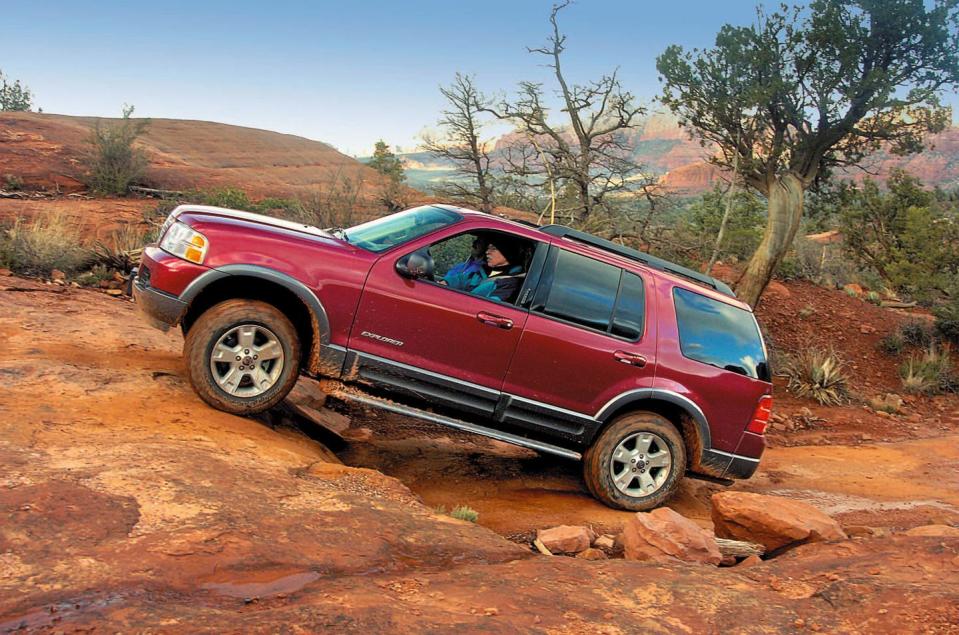
A cold, early-January wind is blowing at the top, and the open-air riders on their Pink Jeep tours shiver in their heavy jackets. Darn, no heated seats in the Explorer! But we have warmth, not to mention six cup holders, a CD changer in the dash, and two rows of back seats complete with DVD movies.
And we got there, on top of Chicken Point, amazed at the view and the achievement. Mom's runabout has moves!
HIGHS: The $$$ incentives, roomy (relatively) three-row seating, no worries about overstimulating your cardiac condition.
LOWS: All-bran brown interior, odd hounds-tooth printed metal on dash.
On the road the Explorer always maintains a certain prudent reserve; it responds slowly to the pedals and steering. Translation: boring. But needs change on the trail. That reserve becomes your friend. You can squeeze on just the right amount of power to ease over rock steps. The brakes are never grabby. If you raise the seat fully, you can see out very well over the low beltline.
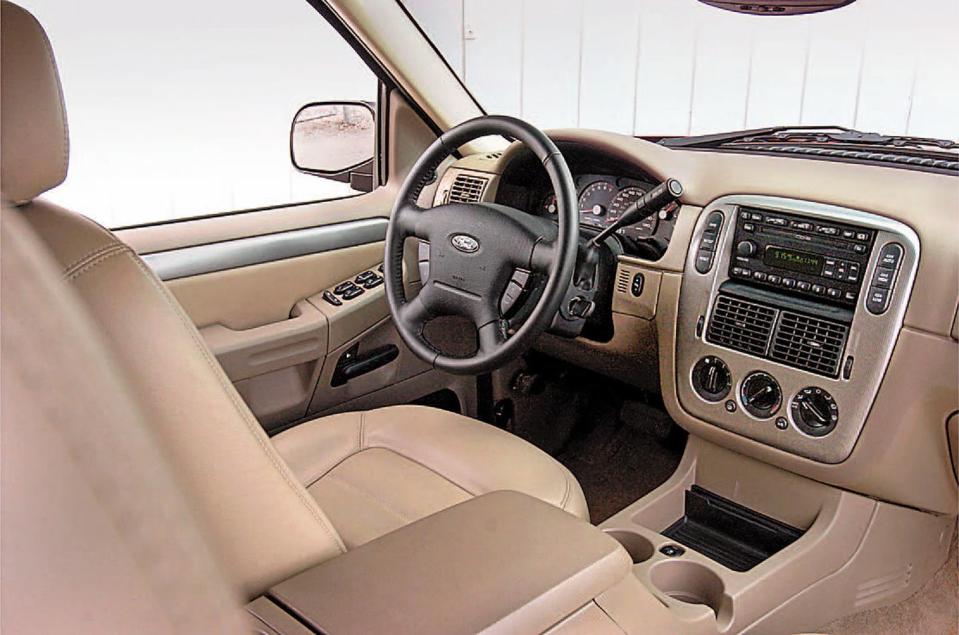
Too bad you can't raise the step bars along the sills. Did we scrape some? Only a few hundred times. On the descent, the trail passes over what Ranney calls a "talus slope," a cascade of rocks and boulders that have fallen from above over time. On trek day they are nicely lubricated with liquid mud from recent rains. Gravity brings everything down, especially if there's feeble traction. There was no possibility of backing up to try a different route. Gravity made the call — down! Poor Explorer! It was naked beneath, no skid plates, the only one of the group lacking them.
Rocks scraped and pummeled the bottom. Sledge-hammer dentistry, that's what it sounded like.

Watch the oil pressure! Steer the wheels over the high spots! Along in here somewhere, our usually well-modulated technical director is heard to say, "This is some sick s**t."
At the trailhead, the Explorer simply drove away, straight to the carwash, same as all the others. Inspecting the bottom later revealed scuffs but no wounds.
THE VERDICT: Anonymity on the rocks.
The Explorer finishes our trials having earned a great deal of respect. It has the best seating accommodations of the bunch; although the low third-row cushions are not great for adults, they're tolerable. The driver's bucket is firm, with good thigh support for those long of leg. Acceleration was middle of the pack, with 0-to-60 in 8.2 seconds. Fuel economy averaged 14 mpg over our evaluation trip, slightly above the mean for the group.
Respect, yes. But lust? Sorry, Mom.
2005 Ford Explorer XLT V-8
239-hp V-8, 5-speed automatic, 4815 lb
Base/as-tested price: $34,675/$39,765
C/D TEST RESULTS
60 mph: 8.2 sec
1/4 mile: 16.4 @ 83 mph
Braking, 70–0 mph: 203 ft
Roadholding, 300-ft-dia skidpad: 0.70 g
C/D observed fuel economy: 14 mpg
Fifth Place: Toyota 4Runner

This is not the expected rating for Toyota's extremely capable SUV. Blame it on this truck's people skills, and on the contrary packaging. The 4Runner has a high floor, not uncommon with body-on-frame construction. But why is the roof low, closer to the floor? And why the low seats, barely off the floor, down at sports-car elevation? Toyota thinks this arrangement adds sport to its sport UV.
The low roof doesn't make entry to the second row easier, either. Once you're seated, comfort is quite good. Hurray for cloth. It almost always feels better than leather. The result is an enveloping, no-sliding-around bench that earned our highest comfort marks for two passengers.
HIGHS: A dancer's chassis muscles, well-calibrated throttle motions, disciplined V-8 noises.
LOWS: Overboosted brakes, hood scoop blocks view, ugly climate controls, ridiculous location for fuel-filler door release.
The 4Runner has sophisticated machinery below. The 4.7-liter V-8 is exceptionally refined in its sounds and vibrations. The test truck had full-time four-wheel drive with a Torsen center differential that's lockable by dash switch. Left to its own, it sends 40 percent of driving torque to the front, up to 53 percent if the rears spin, and reduces front drive to 29 percent during steering.
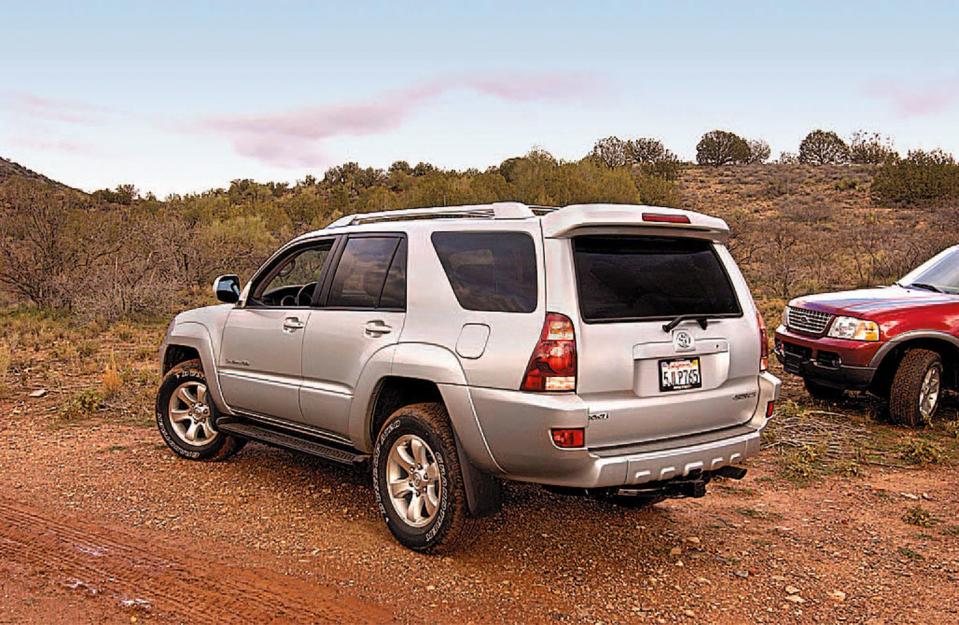
The suspension seems ready for every challenge. It has a surface plushness that impresses on the road, with no bouncing-bobbing in the rough. Good leg muscles. That's the feel. And it's there on the trail, too. The 4Runner flexes and extends over the eroded surfaces with a trained dancer's control of motion.
Throttle calibration is perfectly ramped, too. It's easy to get just the right torque for the task. Too bad about the nonfunctional hood scoop; as you ascend steep crests, the windshield fills with blue sky. What perils lie beyond? Dunno, the damn scoop blocks the view.
For our off-road tasks, we preferred to shut off the hill-descent control, which seemed annoyingly jerky in its interventions. The transfer-case control is a knob; your choices are H4 or L4. All very modern. Old-fashioned, however, is the way the system beeps in protest if a change is attempted in anything but neutral.
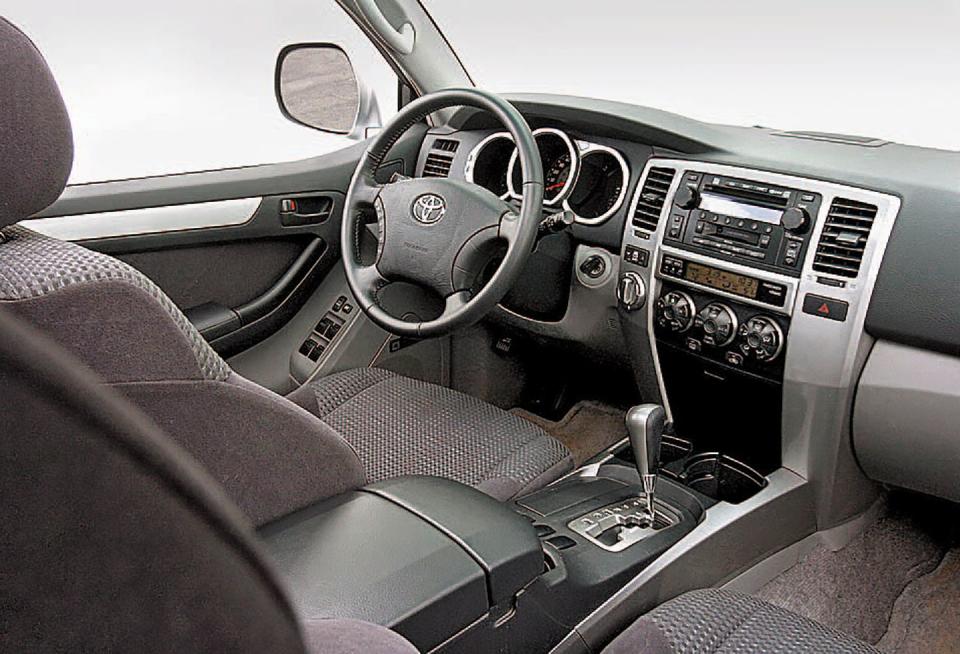
In acceleration the Toyota was second best at 15.7 seconds and 88 mph in the quarter. Braking was best of the bunch at 170 feet from 70 mph. Both on- and off-road, however, the brakes felt overboosted, particularly at low speeds.
THE VERDICT: Unique blend of the capable and the off-putting.
Toyota rarely flubs an assignment. But it happens.
2005 Toyota 4Runner 4WD Sport Edition
237-hp V-6, 6-speed automatic, 4650 lb
Base/as-tested price: $33,055/$36,771
C/D TEST RESULTS
60 mph: 7.2 sec
1/4 mile: 15.7 @ 88 mph
Braking, 70–0 mph: 170 ft
Roadholding, 300-ft-dia skidpad: 0.71 g
C/D observed fuel economy: 13 mpg
Fourth Place: Volkswagen Touareg
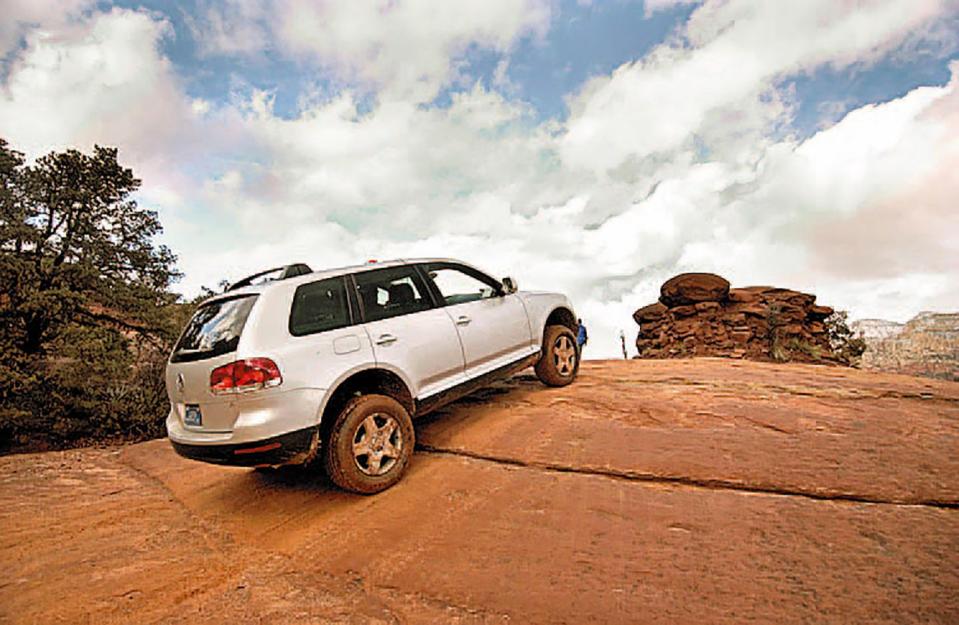
The torque-and-recoil guys among us didn't enjoy the Touareg much. It doesn't leap in response to your nudge of the pedal. They complained about all the transmission downshifting, too. Of course, that's the whole reason for a six-speed. But never mind.
For the record, the six-speed shifts a lot because this mid-sizer weighs in at an astounding 5235 pounds, 300 more than the next-heaviest, the Mitsubishi; 585 more than the welterweight 4Runner. One more reason: The VW's 3.2-liter V-6 is the smallest engine of the group, 0.6 liter less than the next-up Mitsubishi and a whopping 2.5 beneath the Jeep's Hemi.
Any further questions?
HIGHS: Supple long-travel suspension, amazing ground clearance, smooth moves on- and off-road, Lexus-class interior.
LOWS: Four passengers is the comfort limit, not much motor for the money, amazingly heavy at 5235 pounds.

 Yahoo Autos
Yahoo Autos 